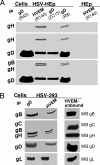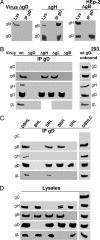The herpesvirus glycoproteins B and H.L are sequentially recruited to the receptor-bound gD to effect membrane fusion at virus entry
- PMID: 16973744
- PMCID: PMC1600001
- DOI: 10.1073/pnas.0606127103
The herpesvirus glycoproteins B and H.L are sequentially recruited to the receptor-bound gD to effect membrane fusion at virus entry
Retraction in
-
The herpesvirus glycoproteins B and H.L are sequentially recruited to the receptor-bound gD to effect membrane fusion at virus entry.Proc Natl Acad Sci U S A. 2007 Feb 27;104(9):3668. doi: 10.1073/pnas.0700703104. Epub 2007 Feb 20. Proc Natl Acad Sci U S A. 2007. PMID: 17360701 Free PMC article. No abstract available.
Abstract
Four glycoproteins (gD, gB, gH, and gL) are required for herpes simplex virus entry into the cell or for cell-cell fusion in transfected cells. gD serves as the receptor-binding glycoprotein and as the trigger of fusion; the other three execute fusion between the viral envelope and the plasma and endocytic membranes or the membranes of adjacent cells and are highly conserved among members of the herpesvirus family. Details of the interaction of gD with gB, gH, and gL were not known. Here, we report that the four glycoproteins assemble into a complex initiated by the interaction of gD with its cellular receptor. gB is recruited to the gD-receptor complex next, even in the absence of gH.gL. gH.gL is recruited next, but only to the receptor-gD-gB ensemble. A complex with the composition receptor-gD-gB-gH.gL is assembled transiently with a life span of 15-30 min in cells exposed to virus but can also be found in infected cells and in cells committed to form polykaryocytes after transfection of the glycoprotein quartet. The results indicate that the complex assembly is a critical step in the process of virus entry and fusion, and that no viral protein other than those that participate in the complex itself is required for complex assembly. These findings imply critical protein-protein interactions among the quartet as herpes simplex virions enter the cells and at cell-cell fusion, define a specific order of recruitment, and place gH.gL as the last link in the process of glycoprotein recruitment to the complex.
Conflict of interest statement
Conflict of interest statement: No conflicts declared.
Figures






Similar articles
-
A Functional Interaction between Herpes Simplex Virus 1 Glycoprotein gH/gL Domains I and II and gD Is Defined by Using Alphaherpesvirus gH and gL Chimeras.J Virol. 2015 Jul;89(14):7159-69. doi: 10.1128/JVI.00740-15. Epub 2015 Apr 29. J Virol. 2015. PMID: 25926636 Free PMC article.
-
Substitution of herpes simplex virus 1 entry glycoproteins with those of saimiriine herpesvirus 1 reveals a gD-gH/gL functional interaction and a region within the gD profusion domain that is critical for fusion.J Virol. 2014 Jun;88(11):6470-82. doi: 10.1128/JVI.00465-14. Epub 2014 Mar 26. J Virol. 2014. PMID: 24672037 Free PMC article.
-
Structure-function analysis of herpes simplex virus glycoprotein B with fusion-from-without activity.Virology. 2008 Dec 20;382(2):207-16. doi: 10.1016/j.virol.2008.09.015. Epub 2008 Oct 23. Virology. 2008. PMID: 18950828
-
The role of herpes simplex virus glycoproteins in the virus replication cycle.Acta Virol. 1998 Apr;42(2):103-18. Acta Virol. 1998. PMID: 9770079 Review.
-
Two Sides to Every Story: Herpes Simplex Type-1 Viral Glycoproteins gB, gD, gH/gL, gK, and Cellular Receptors Function as Key Players in Membrane Fusion.Viruses. 2021 Sep 16;13(9):1849. doi: 10.3390/v13091849. Viruses. 2021. PMID: 34578430 Free PMC article. Review.
Cited by
-
Sialic acid on herpes simplex virus type 1 envelope glycoproteins is required for efficient infection of cells.J Virol. 2007 Apr;81(8):3731-9. doi: 10.1128/JVI.02250-06. Epub 2007 Jan 17. J Virol. 2007. PMID: 17229687 Free PMC article.
-
Antigenic and mutational analyses of herpes simplex virus glycoprotein B reveal four functional regions.J Virol. 2007 Apr;81(8):3827-41. doi: 10.1128/JVI.02710-06. Epub 2007 Jan 31. J Virol. 2007. PMID: 17267495 Free PMC article.
-
Varicella-zoster virus: molecular controls of cell fusion-dependent pathogenesis.Biochem Soc Trans. 2020 Dec 18;48(6):2415-2435. doi: 10.1042/BST20190511. Biochem Soc Trans. 2020. PMID: 33259590 Free PMC article. Review.
-
Design and evaluation of a multi-epitope assembly peptide (MEAP) against herpes simplex virus type 2 infection in BALB/c mice.Virol J. 2011 May 16;8:232. doi: 10.1186/1743-422X-8-232. Virol J. 2011. PMID: 21575169 Free PMC article.
-
Molecular gymnastics at the herpesvirus surface.EMBO Rep. 2006 Oct;7(10):1000-5. doi: 10.1038/sj.embor.7400807. EMBO Rep. 2006. PMID: 17016458 Free PMC article. Review.
References
Publication types
MeSH terms
Substances
LinkOut - more resources
Full Text Sources
Research Materials

